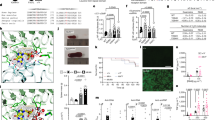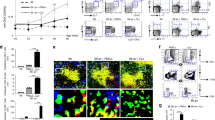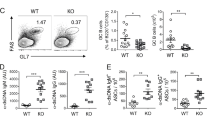Abstract
The NZM2410-derived Sle1a lupus susceptibility locus induces activated autoreactive CD4+ T cells and reduces the number and function of Foxp3+ regulatory T cells (Tregs). In this study, we first showed that Sle1a contributes to autoimmunity by increasing antinuclear antibody production when expressed on either NZB or NZW heterozygous genomes, and by enhancing the chronic graft versus host disease response indicating an expansion of the autoreactive B-cell pool. Screening two non-overlapping recombinants, the Sle1a.1 and Sle1a.2 intervals that cover the entire Sle1a locus, revealed that both Sle1a.1 and Sle1a.2 were necessary for the full Sle1a phenotype. Sle1a.1, and to a lesser extent Sle1a.2, significantly affected CD4+ T-cell activation as well as Treg differentiation and function. Sle1a.2 also increased the production of autoreactive B cells. As the Sle1a.1 and Sle1a.2 intervals contain only 1 and 15 known genes, respectively, this study considerably reduces the number of candidate genes responsible for the production of autoreactive T cells. These results also show that the Sle1 locus is an excellent model for the genetic architecture of lupus, in which a major obligate phenotype results from the coexpression of multiple genetic variants with individual weak effects.
This is a preview of subscription content, access via your institution
Access options
Subscribe to this journal
Receive 6 digital issues and online access to articles
$119.00 per year
only $19.83 per issue
Buy this article
- Purchase on Springer Link
- Instant access to full article PDF
Prices may be subject to local taxes which are calculated during checkout







Similar content being viewed by others
References
Wakeland EK, Liu K, Graham RR, Behrens TW . Delineating the genetic basis of systemic lupus erythematosus. Immunity 2001; 15: 397–408.
Kono DH, Theofilopoulos AN . Genetics of SLE in mice. Springer Semin Immunopathol 2006; 28: 83–96.
Morel L, Rudofsky UH, Longmate JA, Schiffenbauer J, Wakeland EK . Polygenic control of susceptibility to murine systemic lupus erythematosus. Immunity 1994; 1: 219–229.
Waters ST, Fu SM, Gaskin F, Deshmukh US, Sung SSJ, Kannapell CC et al. NZM2328: a new mouse model of systemic lupus erythematosus with unique genetic susceptibility loci. Clin Immunol 2001; 100: 372–383.
Vyse TJ, Rozzo SJ, Drake CG, Izui S, Kotzin BL . Control of multiple autoantibodies linked with a lupus nephritis susceptibility locus in New Zealand black mice. J Immunol 1997; 158: 5566–5574.
Haywood MEK, Rogers NJ, Rose SJ, Boyle J, McDermott A, Rankin JM et al. Dissection of BXSB lupus phenotype using mice congenic for chromosome 1 demonstrates that separate intervals direct different aspects of disease. J Immunol 2004; 173: 4277–4285.
Heidari Y, Bygrave AE, Rigby RJ, Rose KL, Walport MJ, Cook HT et al. Identification of chromosome intervals from 129 and C57BL/6 mouse strains linked to the development of systemic lupus erythematosus. Genes Immun 2006; 7: 592–599.
Ichii O, Konno A, Sasaki N, Endoh D, Hashimoto Y, Kon Y . Autoimmune glomerulonephritis induced in congenic mouse strain carrying telomeric region of chromosome 1 derived from MRL/MpJ. Histol Histopathol 2008; 23: 411–422.
Moser KL, Kelly JA, Lessard CJ, Harley JB . Recent insights into the genetic basis of systemic lupus erythematosus. Genes Immun 2009; 10: 373–379.
Morel L, Mohan C, Yu Y, Croker BP, Tian N, Deng A et al. Functional dissection of systemic lupus erythematosus using congenic mouse strains. J Immunol 1997; 158: 6019–6028.
Carlucci F, Cortes-Hernandez J, Fossati-Jimack L, Bygrave AE, Walport MJ, Vyse TJ et al. Genetic dissection of spontaneous autoimmunity driven by 129-derived chromosome 1 loci when expressed on C57BL/6 mice. J Immunol 2007; 178: 2352–2360.
Sobel ES, Satoh M, Chen WF, Wakeland EK, Morel L . The major murine systemic lupus erythematosus susceptibility locus Sle1 results in abnormal functions of both B and T cells. J Immunol 2002; 169: 2694–2700.
Morel L, Blenman KR, Croker BP, Wakeland EK . The major murine systemic lupus erythematosus susceptibility locus, Sle1, is a cluster of functionally related genes. Proc Natl Acad Sci USA 2001; 98: 1787–1792.
Wandstrat AE, Nguyen C, Limaye N, Chan AY, Subramanian S, Tian XH et al. Association of extensive polymorphisms in the SLAM/CD2 gene cluster with murine lupus. Immunity 2004; 21: 769–780.
Boackle SA, Holers VM, Chen XJ, Szakonyi G, Karp DR, Wakeland EK et al. Cr2, a candidate gene in the murine Sle1c lupus susceptibility locus, encodes a dysfunctional protein. Immunity 2001; 15: 775–785.
Douglas KB, Windels DC, Zhao J, Gadeliya AV, Wu H, Kaufman KM et al. Complement receptor 2 polymorphisms associated with systemic lupus erythematosus modulate alternative splicing. Genes Immun 2009; 10: 457–469.
Wu H, Boackle SA, Hanvivadhanakul P, Ulgiati D, Grossman JM, Lee Y et al. Association of a common complement receptor 2 haplotype with increased risk of systemic lupus erythematosus. Proc Natl Acad Sci USA 2007; 104: 3961–3966.
Chen Y, Cuda C, Morel L . Genetic determination of T cell help in loss of tolerance to nuclear antigens. J Immunol 2005; 174: 7692–7702.
Chen Y, Perry D, Boackle SA, Sobel ES, Molina H, Croker BP et al. Several genes contribute to the production of autoreactive B and T cells in the murine lupus susceptibility locus Sle1c. J Immunol 2005; 175: 1080–1089.
Cuda CM, Wan S, Sobel ES, Croker BP, Morel L . Murine lupus susceptibility locus Sle1a controls regulatory T cell number and function through multiple mechanisms. J Immunol 2007; 179: 7439–7447.
Wan S, Xia C, Morel L . IL-6 produced by dendritic cells from lupus-prone mice inhibits CD4+CD25+ T cell regulatory functions. J Immunol 2007; 178: 271–279.
Morel L, Tian XH, Croker BP, Wakeland EK . Epistatic modifiers of autoimmunity in a murine model of lupus nephritis. Immunity 1999; 11: 131–139.
Giles BM, Tchepeleva SN, Kachinski JJ, Ruff K, Croker BP, Morel L et al. Augmentation of NZB autoimmune phenotypes by the Sle1c murine lupus susceptibility interval. J Immunol 2007; 178: 4667–4675.
Bradley DS, Jennette JC, Cohen PL, Eisenberg RA . Chronic graft versus host disease-associated autoimmune manifestations are independently regulated by different MHC class-II loci. J Immunol 1994; 152: 1960–1969.
Chen FQ, Maldonado MA, Madaio M, Eisenberg RA . The role of host (endogenous) T cells in chronic graft-versus-host autoimmune disease. J Immunol 1998; 161: 5880–5885.
Rahman ZSM, Niu H, Perry D, Wakeland E, Manser T, Morel L . Expression of the autoimmune Fcgr2b NZW allele fails to be upregulated in germinal center B cells and is associated with increased IgG production. Genes Immun 2007; 8: 604–612.
Maloy KJ, Salaun L, Cahill R, Dougan G, Saunders NJ, Powrie F . CD4+CD25+ T(R) cells suppress innate immune pathology through cytokine-dependent mechanisms. J Exp Med 2003; 197: 111–119.
Croker BP, Salomon DR . Transplant rejection, transplant glomerulopathology and recurrent and de-novo glomerulonephritis. In: Tisher CC, Brenner BM (eds). Renal Pathology. J.B. Lippincott Company: Philadelphia, 1989, pp 1518–1544.
Harley IT, Kaufman KM, Langefeld CD, Harley JB, Kelly JA . Genetic susceptibility to SLE: new insights from fine mapping and genome-wide association studies. Nat Rev Genet 2009; 10: 285–290.
Morel L, Tian XH, Croker BP, Wakeland EK . Epistatic modifiers of autoimmunity in a murine model of lupus nephritis. Immunity 1999; 11: 131–139.
Mohan C, Alas E, Morel L, Yang P, Wakeland EK . Genetic dissection of SLE pathogenesis—Sle1 on murine chromosome 1 leads to a selective loss of tolerance to H2A/H2B/DNA subnucleosomes. J Clin Invest 1998; 101: 1362–1372.
Kumar KR, Li LN, Yan M, Bhaskarabhatla M, Mobley AB, Nguyen C et al. Regulation of B cell tolerance by the lupus susceptibility gene Ly108. Science 2006; 312: 1665–1669.
Greenwald RJ, Freeman GJ, Sharpe AH . The B7 family revisited. Ann Rev Immunol 2005; 23: 515–548.
Odegard JM, DiPlacido LD, Greenwald L, Kashgarian M, Kono DH, Dong C et al. ICOS controls effector function but not trafficking receptor expression of kidney-infiltrating effector T cells in murine lupus. J Immunol 2009; 182: 4076–4084.
Steinmetz OM, Turner JE, Paust HJ, Lindner M, Peters A, Heiss K et al. CXCR3 mediates renal Th1 and Th17 immune response in murine lupus nephritis. J Immunol 2009; 183: 4693–4704.
Tipping PG, Kitching AR . Glomerulonephritis, Th1 and Th2: what's new? Clin Exp Immunol 2005; 142: 207–215.
Chung EY, Liu J, Homma Y, Zhang Y, Brendolan A, Saggese M et al. Interleukin-10 expression in macrophages during phagocytosis of apoptotic cells is mediated by homeodomain proteins Pbx1 and Prep-1. Immunity 2007; 27: 952–964.
Penkov D, Palazzolo M, Mondino A, Blasi F . Cytosolic sequestration of Prep1 influences early stages of T cell development. PLoS ONE 2008; 3: e2424.
Ma CS, Nichols KE, Tangye SG . Regulation of cellular and humoral immune responses by the SLAM and SAP families of molecules. Ann Rev Immunol 2007; 25: 337–379.
Calpe S, Erdos E, Liao GX, Wang NH, Rietdijk S, Simarro M et al. Identification and characterization of two related murine genes, Eat2a and Eat2b, encoding single SH2-domain adapters. Immunogenetics 2006; 58: 15–25.
Croker BP, Gilkeson G, Morel L . Genetic interactions between susceptibility loci reveal epistatic pathogenic networks in murine lupus. Genes Immun 2003; 4: 575–585.
Liu K, Li QZ, Yu Y, Liang C, Subramanian S, Zeng Z et al. Sle3 and Sle5 can independently couple with Sle1 to mediate severe lupus nephritis. Genes Immun 2007; 8: 634–645.
Morris SC, Cheek RL, Cohen PL, Eisenberg RA . Autoantibodies in chronic graft versus host result from cognate T-B interactions. J Exp Med 1990; 171: 503–517.
Acknowledgements
This work was supported by the National Institutes of Health Grants R01 AI 45050 (to LM) and T32 AR007603 (to CC). We thank Dr Minoru Sato and the members of the Morel lab for stimulating discussions, as well as Ms Xuekun Su for outstanding animal care.
Author information
Authors and Affiliations
Corresponding author
Ethics declarations
Competing interests
The authors declare no conflict of interest.
Rights and permissions
About this article
Cite this article
Cuda, C., Zeumer, L., Sobel, E. et al. Murine lupus susceptibility locus Sle1a requires the expression of two sub-loci to induce inflammatory T cells. Genes Immun 11, 542–553 (2010). https://doi.org/10.1038/gene.2010.23
Received:
Accepted:
Published:
Issue Date:
DOI: https://doi.org/10.1038/gene.2010.23
Keywords
This article is cited by
-
D-mannose ameliorates autoimmune phenotypes in mouse models of lupus
BMC Immunology (2021)
-
Resistance to plague of Mus spretus SEG/Pas mice requires the combined action of at least four genetic factors
Genes & Immunity (2013)
-
The SLE-associated Pbx1-d isoform acts as a dominant-negative transcriptional regulator
Genes & Immunity (2012)
-
Defective response of CD4+ T cells to retinoic acid and TGFβ in systemic lupus erythematosus
Arthritis Research & Therapy (2011)
-
The lupus phenotype in B6.NZBc1 congenic mice reflects interactions between multiple susceptibility loci and a suppressor locus
Genes & Immunity (2011)



